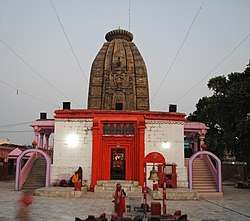Surya
Surya (/ˈsuːrjə/;[4] Sanskrit: सूर्य, IAST: Sūrya) is a Sanskrit word that means the Sun.[5] Synonyms of Surya in ancient Indian literature include Aditya, Arka, Bhanu, Savitr, Pushan, Ravi, Martanda, Mitra, Bhaskara and Vivasvan.[6][7][8]
| Surya | |
|---|---|
God of The Sun Lord of Light and Day | |
| Member of Navagraha | |
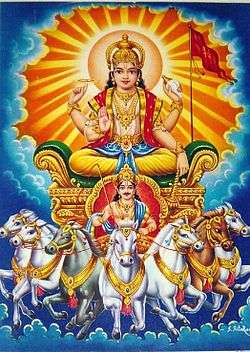 Surya (c. 1940) | |
| Other names | Aditya, Bhaskara, Divakara, Surya Narayana, Shiva Surya, Hiranyagarba |
| Affiliation | Deva, Navagraha, Adityas, Saguna Brahman (Panchayatana puja) |
| Abode | Suryaloka |
| Planet | Sun |
| Mantra | "Java Kusuma Sankasam, Kashyapeyam Mahadyutim, Tamorim Sarva Papagham, Pranotoshmi Divakaram"[1] and "Om Surya Devaay namah" |
| Weapon | Wand |
| Day | Sunday |
| Mount | Chariot drawn by seven horses Charioteer: Aruṇa[2] |
| Personal information | |
| Parents | |
| Consort | Puranic Sandhya and Chhaya Vedic Ushas and Ratri |
| Children | Shraddhadeva Manu, Yama, Yami, Ashwins, Shani, Tapati, Bhadra, Sugriva, Karna and Suvarchala |
| Equivalents | |
| Greek equivalent | Helios[3] |
| Roman equivalent | Apollo and Sol |
| Mesopotamian equivalent | Utu |
| Egyptian equivalent | Ra |
Surya also connotes the solar deity in Hinduism,[9] particularly in the Saura tradition found in states such as Rajasthan, Gujarat, Madhya Pradesh, Bihar, Maharashtra, Uttar Pradesh, Jharkhand and Odisha. Surya is one of the five deities considered as equivalent aspects and means to realizing Brahman in the Smarta Tradition.[10] Surya's iconography is often depicted riding a chariot harnessed by horses, often seven in number[2] which represent the seven colours of visible light, and seven days in a week.[5][11] In medieval Hinduism, Surya is also an epithet for the major Hindu gods Shiva, Brahma and Vishnu.[9][12] In some ancient texts and arts, Surya is presented syncretically with Indra, Ganesha or others.[6][11] Surya as a deity is also found in the arts and literature of Buddhism and Jainism.[13][14]
Surya is depicted with a Chakra which is also interpreted as Dharmachakra.[15] Surya is one of the twelve heavenly houses in the zodiac system of Hindu astrology. Surya or Ravi is the basis of Ravivara, or Sunday, in the Hindu calendar.[16] Major festivals and pilgrimages in reverence of Surya include Makar Sankranti, Pongal, Samba Dashami, Ratha Sapthami, Chath puja and Kumbh Mela.[17][18][19]
Having survived as a primary deity in Hinduism arguably better and longer than any other of the original Vedic deities apart from Vishnu, the worship of Surya declined greatly around the 13th century, perhaps as a result of the Muslim conquest of north India. New Surya temples virtually ceased to be built, and some were later converted to a different dedication, generally Shiva. A number of important Surya temples remain, but many are no longer in worship. In various respects, Surya has tended to be merged into Shiva, or seen as subsidiary to him.[20]
Texts and history
Vedic

The oldest surviving Vedic hymns, such as the hymn 1.115 of the Rigveda, mention Sūrya with particular reverence for the "rising sun” and its symbolism as dispeller of darkness, one who empowers knowledge, the good and all life.[5][21] However, the usage is context specific. In some hymns, the word Surya simply means sun as an inanimate object, a stone or a gem in the sky (Rigvedic hymns 5.47, 6.51 and 7.63); while in others it refers to a personified deity.[5][22]
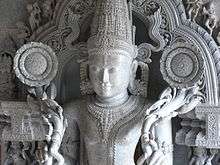
The Vedas assert Sun (Surya) to be the creator of the material universe (Prakriti).[23] In the layers of Vedic texts, Surya is one of the several trinities along with Agni and either Vayu or Indra, which are presented as an equivalent icon and aspect of the Hindu metaphysical concept called the Brahman.[24]
In the Brahmanas layer of Vedic literature, Surya appears with Agni (fire god) in the same hymns.[25] Surya is revered for the day, while Agni for its role during the night.[25] The idea evolves, states Kapila Vatsyayan, where Surya is stated to be Agni as the first principle and the seed of the universe.[26] It is in the Brahmanas layer of the Vedas,[27][28] and the Upanishads that Surya is explicitly linked to the power of sight, to visual perception and knowledge. He is then interiorized to be the eye as ancient Hindu sages suggested abandonment of external rituals to gods in favor of internal reflections and meditation of gods within, in one's journey to realize the Atman (soul, self) within, in texts such as the Brihadaranyaka Upanishad, Chandogya Upanishad, Kaushitaki Upanishad and others.[29][30][31]
Epics
The Mahabharata epic opens its chapter on Surya that reverentially calls him as the "eye of the universe, soul of all existence, origin of all life, goal of the Samkhyas and Yogis, and symbolism for freedom and spiritual emancipation.[5]
In the Mahabharata, Karna is the son of Surya and unmarried princess Kunti.[5] The epic describes Kunti's trauma as an unmarried mother, then abandonment of Karna, followed by her lifelong grief. Baby Karna is found and adopted by a charioteer but he grows up to become a great warrior and one of the central characters in the great battle of Kurukshetra where he fights his half brothers.[32]
Buddhist
_p406_T50.jpg)
Surya is celebrated as a deity in Buddhist artwork, such as the ancient works attributed to Ashoka. He appears in a relief at the Mahabodhi temple in Bodhgaya, riding in a chariot pulled by four horses, with Usha and Prattyusha on his sides.[13] Such artwork suggests that the Surya as symbolism for the victory of good over evil is a concept adopted in Buddhism from an earlier Indic tradition.[13]
Greek and Persian influences
Sun is a common deity in ancient and medieval cultures found in South America, Europe, Africa and Asia. The features and mythologies of Surya share resemblances with Hvare-khshaeta of pre-Islam Persia, and the Helios-Sol deity in the Greek-Roman culture.[21][33][34] Surya is a Vedic deity, states Elgood, but its deity status was strengthened from the contacts between ancient Persia and India during the Kushan era, as well as after the 8th-century when Sun-worshipping Parsees moved to India.[35] Some Greek features were incorporated into Surya iconography in post-Kushan era, around mid 1st millennium, according to Elgood.[35]
Iconography
The iconography of Surya in Hinduism varies with its texts. He is typically shown as a resplendent standing person holding sunflower flower in both his hands, riding a chariot pulled by one or more horses typically seven.[36] The seven horses are named after the seven meters of Sanskrit prosody: Gayatri, Brihati, Ushnih, Jagati, Trishtubha, Anushtubha and Pankti.[5]
The Brihat Samhita, a Hindu text that describes architecture, iconography and design guidelines, states that Surya should be shown with two hands and wearing a crown. In contrast, the Vishnudharmottara, another Hindu text on architecture, states Surya iconography should show him with four hands, with flowers in two hands, a staff in third, and in fourth he should be shown to be holding writing equipment (Kundi palm leaf and pen symbolizing knowledge).[5] His chariot driver in both books is stated to be Aruṇa who is seated.[5] Two females typically flank him, who represent the dawn goddesses named Usha and Pratyusha. The goddesses are shown to be shooting arrows, a symbolism for their initiative to challenge darkness.[35]
The iconography of Surya has also varied over time. In some ancient arts, particularly from the early centuries of the common era, his iconography is similar to those found in Persia and Greece suggesting likely adoption of Greek, Iranian and Scythian influences.[5][34] After the Greek and Kushan influences arrived in ancient India, some Surya icons of the period that followed show him wearing a cloak and high boots.[35][37] In some Buddhist artwork, his chariot is shown as being pulled by four horses.[13] The doors of Buddhist monasteries of Nepal show him, along with the Chandra (moon god), symbolically with Surya depicted as a red circle with rays.[38]
Aniconic symbols of Surya include the Swastika and the ring-stone.[35]
Arka, Mitra and other synonyms
Surya in Indian literature is referred to by various names, which typically represent different aspects or phenomenological characteristics of the Sun. Thus, Savitr refers to one that rises and sets, Aditya means one with splendor, Mitra refers to Sun as "the great luminous friend of all mankind",[39] while Pushan refers to Sun as illuminator that helped the Devas win over Asuras who use darkness.[40] Arka, Mitra, Aditya, Tapan, Ravi and Surya have different characteristics in early mythologies, but by the time of the epics they are synonymous.[40]
The term "Arka" is found more commonly in temple names of north India and in the eastern parts of India. The 11th century Konark Temple in Odisha is named after a composite word "Kona and Arka", or "Arka in the corner".[41] Other Surya temples named after Arka include Uttararka and Lolarka in Uttar Pradesh, and Balarka in Rajasthan. Another 10th-century sun temple ruin is in Bahraich, Uttar Pradesh named Balarka Surya Mandir, which was destroyed in the 14th century during the Turkish invasions.
Astronomy
The Sun causes day and night on the earth,
because of revolution,
when there is night here, it is day on the other side,
the sun does not really rise or sink.
Surya as an important heavenly body appears in various Indian astronomical texts in Sanskrit, such as the 5th century Aryabhatiya by Aryabhata, the 6th century Romaka by Latadeva and Panca Siddhantika by Varahamihira, the 7th century Khandakhadyaka by Brahmagupta and the 8th century Sisyadhivrddida by Lalla.[44] These texts present Surya and various planets and estimate the characteristics of the respective planetary motion.[44] Other texts such as Surya Siddhanta dated to have been complete sometime between the 5th century and 10th century present their chapters on various planets with deity mythologies.[44]
The manuscripts of these texts exist in slightly different versions, present Surya- and planets-based calculation and its relative motion to earth. These vary in their data, suggesting that the text were open and revised over their lives.[45][46][47] For example, the 1st millennium CE Hindu scholars had estimated the sidereal length of a year as follows, from their astronomical studies, with slightly different results:[48]
| Hindu text | Estimated length of the sidereal year[48] |
| Surya Siddhanta | 365 days, 6 hours, 12 minutes, 36.56 seconds |
| Paulica Siddhanta | 365 days, 6 hours, 12 minutes, 36 seconds |
| Paracara Siddhanta | 365 days, 6 hours, 12 minutes, 31.50 seconds |
| Arya Siddhanta | 365 days, 6 hours, 12 minutes, 30.84 seconds |
| Laghu Arya Siddhanta | 365 days, 6 hours, 12 minutes, 30 seconds |
| Siddhanta Shiromani | 365 days, 6 hours, 12 minutes, 9 seconds |
The oldest of these is likely to be the Surya Siddhanta, while the most accurate is the Siddhanta Shiromani.[48]
Zodiac and astrology
Surya's synonym Ravi is the root of the word 'Ravivara' or Sunday in the Hindu calendar.[49] In both Indian and Greek-Roman nomenclature for days of the week, the Sunday is dedicated to the Sun.
Surya is a part of the Navagraha in Hindu zodiac system. The role and importance of the Navagraha developed over time with various influences. Deifying the sun and its astrological significance occurred as early as the Vedic period and was recorded in the Vedas. The earliest work of astrology recorded in India is the Vedanga Jyotisha which began to be compiled in the 14th century BCE. It was possibly based on works from the Indus Valley Civilization as well as various foreign influences.[50] Babylonian astrology which was the first to develop astrology and the calendar, and was adopted by multiple civilizations including India.[51][52]
The Navagraha developed from early works of astrology over time. The Sun and various classical planets were referenced in the Atharvaveda around 1000 BCE. The Navagraha was furthered by additional contributions from Western Asia, including Zoroastrian and Hellenistic influences.[53] The Yavanajataka, or 'Science of the Yavanas', was written by the Indo-Greek named "Yavanesvara" ("Lord of the Greeks") under the rule of the Western Kshatrapa king Rudrakarman I. The Yavanajataka written in 120 CE is often attributed to standardizing Indian astrology. The Navagraha would further develop and culminate in the Shaka era with the Saka, or Scythian, people. Additionally the contributions by the Saka people would be the basis of the Indian national calendar, which is also called the Saka calendar.
The Hindu calendar is a Lunisolar calendar which records both lunar and solar cycles. Like the Navagraha, it was developed with the successive contributions of various works.
In Buddhism
In the Buddhism of the Far East, Surya is one of the twelve Devas, as guardian deities, who are found in or around Buddhist shrines (Jūni-ten, 十二天).[54] In Japan, he has been called "Nit-ten".[55] He joins these other eleven Devas of Buddhism, found in Japan and other parts of southeast Asia: Indra (Taishaku-ten), Agni (Ka-ten), Yama (Emma-ten), Nirrti (Rasetsu-ten), Vayu (Fu-ten), Ishana (Ishana-ten), Kubera (Tamon-ten), Varuna (Sui-ten), Brahma (Bon-ten), Prithvi (Chi-ten), Chandra (Gat-ten).[55][56][57]
On the Mount Meru buddhist cosmological system, Surya is considered a female deity, contrasting a male lunar god.[58]
Sun Temples
Surya temples are found in many parts of India. More common than Surya temples are artwork related to Surya, which are found in all types of temples of various traditions within Hinduism, such as the Hindu temples related to Shiva, Vishnu, Ganesha and Shakti.[59] Reliefs on temple walls, forts and artwork above doorways of many Hindu monasteries feature Surya.[59][60]
Many of the temples that contain Surya icons and artwork are dated to the second half of the 1st millennium CE and early centuries of the 2nd millennium. The 11th-century Vaishnava temple at Kadwaha in Madhya Pradesh, for example, features a Surya artwork along with many other gods and goddesses at its doorway.[59] The 8th and 9th century goddess (Shaktism) temples of central India, similarly engrave Surya along with other Hindu gods within the temple.[59] The six century Shiva temple at Gangadhar in Rajasthan includes Surya.[61] Similar mentions are found in stone inscriptions found near Hindu temples, such as the 5th century Mandasor inscription.[62] These temples, states Michael Meister, do not glorify one god or goddess over the other, but present them independently and with equal emphasis in a complex iconography.[59]
Cave temples of India, similarly, dedicated to different gods and goddesses feature Surya.[63][64] For example, the 6th century carvings in the Ellora Caves in Maharashtra as well as the 8th and 9th century artworks there, such as Cave 25, the Kailasha Temple (Cave 16) and others feature complete iconography of Surya.[65][66]
Hindu temples predominantly have their primary entrance facing east, and their square principle based architecture is reverentially aligned the direction of the rising Surya.[67][68] This alignment towards the sunrise is also found in most Buddhist and Jaina temples in and outside of India.[69][70]
Dedicated temples
India most worshiped Surya temple is the Deo Surya Mandir. Sun Temple of Deo is one of the most remarkable, major crowd-puller and notable temple and religious place in Deo Bihar India for chhath puja. Deo Sun Temple Built in during the 8th century.[71]
The most famous Surya temple is the Konark Sun Temple, a World Heritage Site in Orissa.[72] Constructed in the 13th century by the Eastern Ganga dynasty, on a pre-existing pilgrimage site for Surya god, the temple architecture mimics a grand chariot with twelve wheels pulled by seven horses.[72][73] The temple features Surya in three representations, with the main large Surya destroyed and the temple damaged over repeated Muslim invasions.[74] Besides Konark, there are two other sun temples in Orissa called Biranchi Narayan Sun Temple.
There are sun temples in many parts of India, such as Modhera, Gujarat.[75] It was sponsored by King Bhimdev of the Chaulukya dynasty. Other major Surya temples are found in Arasavalli, Andhra Pradesh, Kanakaditya Temple in Kasheli (Dist ratnagiri) – Maharashtra, near the famous Galtaji's temple in Jaipur, Rajasthan and in clusters of Navagraha temples in Tamil Nadu and Assam.
Adithyapuram Sun Temple is a Hindu temple located in Iravimangalam near Kaduthuruthy in Kottayam district in the Indian state of Kerala dedicated to Surya. It is noted as the only Surya shrine in the Kerala state.[76][77]
The Martand Sun Temple in Jammu and Kashmir was destroyed by Islamic armies.[78] A surviving Surya temple in northern India is Kattarmal Surya mandir in Almora District, Uttarakhand created by King Kattarmal in the 12th century.
The Gurjars were essentially sun worshipers and some of the sun temples were erected by them during the medieval period.[79] The sun temple known as Jayaditya was constructed by Gurjar king of Nandipuri, Jayabhatta II. This temple is situated at Kotipura near Kapika in the Bharukachha district.[80] The Surya temple of Bhinmal known as Jagaswami Surya temple was also erected during this period.[81]
Surya temples outside India
The Sun Temple of Multan (in modern-day Pakistan) contained a revered statue of Surya. It was one of the focal points of Hindu-Muslim religious conflicts.[82] After 871 CE, Multan (Panjab) was under the rule by Arab princes, who kept the Surya temple hostage and desecrated it,[83] in order to threaten its destruction if the Hindu Gurjara attacked them.[84] The early Muslim rulers taxed Hindu pilgrims for the privilege to visit the Surya temple, and this provided these rulers an important source of revenue.[85] The Surya temple was destroyed by Ismaili Shia rulers in the late 10th century, who built a mosque atop the site, abandoning the Sunni congregational mosque in Multan.[86] This Ismaili Shia mosque atop the Sun Temple's ruins was then destroyed by the Sunni ruler Mahmud of Ghazni, the Surya temple was not rebuilt and an empty space left in place, actions that helped re-establish the importance of the Sunni mosque in Multan.[86]
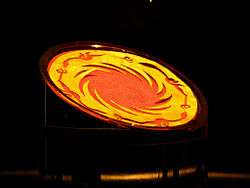
While Shiva and Vishnu are more common in 1st millennium southeast Asian artwork such as those found in Cambodia and Thailand, archaeological evidence suggest god Surya were among the pantheon of ideas adopted early in these regions and retained after Buddhism became the dominant tradition.[87]
In Kabul Khir Khana a large Hindu temple complex of two distinct periods. The first period consisted of a mud-brick temple with possible human sacrifice remains dedicating it. This was then superseded by three distinct sanctuaries built of schist slabs, surrounded by subsidiary buildings of diaper masonry construction and an open-air altar in a semi-circular enclosure. The most important finds were two marble statues of Surya, the first example found during the original excavations (1934, Delegation Archaeologique Française Afghanistan), the second example found by accident in 1980.
In Nepal, many Surya temples and artworks trace to the medieval era, such as the 11th-century Thapahiti and Saugal-tol, and 12th century Naksal stone sculptures.[88]
Artifacts discovered at the Sanxingdui culture founded c 1,600 BCE, about 40 km from present day Chengdu, capital city of Sichuan province China reveal an ancient worship of sun-deity, similar to Surya. The artifacts include a gold sheet with design of four birds flying around the sun deity, and a bronze sculpture of the surya-chakra.[89]
Surya in Indian culture
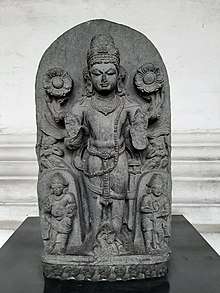
Festivals
Various festivals mark deity Surya and these vary regionally in India. Pongal or Makara Sankaranti is the most widely celebrated Hindu festival dedicated to the Sun God. These celebrate a good harvest. Other festivals that focus on Surya include Chhath of Bihar, eastern Uttar Pradesh and the neighboring regions, Samba Dashami and Ratha Saptami are also major festivals celebrated in honour of Surya; Chhath is celebrated immediately after Diwali with fasting for three days followed by bathing in river or tank with remembrance of Sun.[90] Similarly Aytar Puja is celebrated in Goa.[91] The latter is known as Aditya Ranubai in Maharashtra.[92]
The second day of the Pongal harvest festival is dedicated to Surya in Tamil Nadu, and is called the "Surya Pongal".[93]
Another festival named Kartik Puja marks Surya, along with Shiva, Vishnu, Lakshmi, Radha, Krishna and Tulsi. It is observed by Hindu women, typically with visit to rivers such as the Ganges, socialization and group singing.[94]
Dances
The repertoire of classical Indian dances such as the Bharatanatyam include poses that signify rays of light beaming towards all of the universe, as a form of homage to Surya.[95]
Surya Namaskar

Sūrya namaskāra literally means sun salutation. It is a Yoga warm up routine based on a sequence of gracefully linked asanas.[97] The nomenclature refers to the symbolism of Sun as the soul and the source of all life. It is relatively a modern practice that developed in the 20th century.[98] A yogi may develop a personalized yoga warm up routine as surya-namaskar to precede his or her asana practice.[99]
The Gayatri Mantra is associated with Surya (Savitr). The mantra's earliest appearance is in the hymn 3.62.10 of the Rigveda.[100]
Might we make our own that desirable effulgence of god Savitar, who will rouse forth our insights.
Gallery
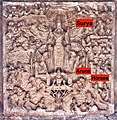 8th century ceiling carving of Surya at Pattadakal Virupaksha Hindu temple.
8th century ceiling carving of Surya at Pattadakal Virupaksha Hindu temple.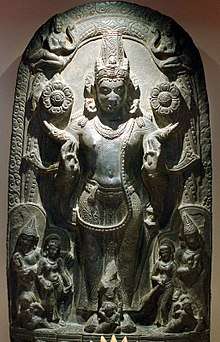 Surya statue
Surya statue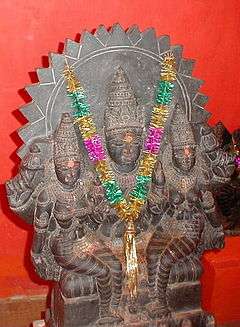 Surya with consorts Saranyu and Chhaya
Surya with consorts Saranyu and Chhaya Pongal in Tamil Nadu
Pongal in Tamil Nadu Surya festival Makar Sankranti
Surya festival Makar Sankranti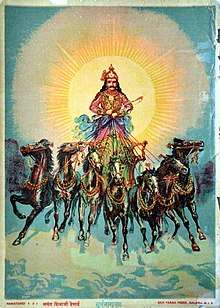 Surya Narayana
Surya Narayana
See also
Further reading
- Pingree, David (1973). "The Mesopotamian Origin of Early Indian Mathematical Astronomy". Journal for the History of Astronomy. SAGE. 4 (1): 1–12. Bibcode:1973JHA.....4....1P. doi:10.1177/002182867300400102.CS1 maint: ref=harv (link)
- Pingree, David (1981). Jyotihśāstra : Astral and Mathematical Literature. Otto Harrassowitz. ISBN 978-3447021654.
- Yukio Ohashi (1999). Johannes Andersen (ed.). Highlights of Astronomy, Volume 11B. Springer Science. ISBN 978-0-7923-5556-4.CS1 maint: ref=harv (link)
External links
| Wikimedia Commons has media related to Surya. |
- An ancient hymn to Surya – from the Rig Veda
- Sun worship in Odisha RK Sahu (2012), Orissa Review
- Iconography of Surya in the temple art of Orissa RK Sahu (2011), Orissa Review
- Bhatia, Baldev (21 February 2019). Your Planet Remedies - Special Edition. Lulu Press, Inc. ISBN 978-0-359-45082-4.
- Jansen, Eva Rudy. The Book of Hindu Imagery: Gods, Manifestations and Their Meaning, p. 65.
- Pande, Govind Chandra (2007). A golden chain of civilizations : Indic, Iranic, Semitic, and Hellenic up to c. 600 B.C. (1. publ. ed.). New Delhi: Project of History of Indian Science, Philosophy, and Culture. p. 572. ISBN 978-8187586289. Retrieved 20 April 2018.
- Oxford Dictionaries
- Roshen Dalal (2010). Hinduism: An Alphabetical Guide. Penguin Books India. pp. 399–401. ISBN 978-0-14-341421-6.
- Roshen Dalal (2010). Hinduism: An Alphabetical Guide. Penguin Books India. pp. 5, 39, 247, 343, 399–400. ISBN 978-0-14-341421-6.
- Alexandra Anna Enrica van der Geer (2008). Animals in Stone: Indian Mammals Sculptured Through Time. BRILL. pp. 236–. ISBN 978-90-04-16819-0.
- Gopal, Madan (1990). K.S. Gautam (ed.). India through the ages. Publication Division, Ministry of Information and Broadcasting, Government of India. p. 76.
- Roshen Dalal (2010). Hinduism: An Alphabetical Guide. Penguin Books India. p. 343. ISBN 978-0-14-341421-6.
- Flood, Gavin (1996), An Introduction to Hinduism, Cambridge University Press, p. 113, ISBN 9780521438780
- Shimkhada, Deepak (1984). "The Masquerading Sun: A Unique Syncretic Image in Nepal". Artibus Asiae. 45 (2/3): 223–229. doi:10.2307/3249732. JSTOR 3249732.
- T. Richard Blurton (1993). Hindu Art. Harvard University Press. p. 118. ISBN 978-0-674-39189-5.
- Rajiv Kumar and Anil Kumar (2010), A UNIQUE SŪRYA CARVING ON AŚOKAN RAILINGS AT BODHGAYA Annals of the Bhandarkar Oriental Research Institute, Vol. 91, pp. 87-89
- R. T. Vyas; Umakant Premanand Shah (1995). Studies in Jaina Art and Iconography and Allied Subjects. Abhinav Publications. pp. 23–24. ISBN 978-81-7017-316-8.
- Journal, Volumes 11-14. Asiatic Society. 1969. p. 131.
- Roshen Dalal (2010). Hinduism: An Alphabetical Guide. Penguin Books India. p. 89. ISBN 978-0-14-341421-6.
- J. Gordon Melton (2011). Religious Celebrations: An Encyclopedia of Holidays, Festivals, Solemn Observances, and Spiritual Commemorations. ABC-CLIO. pp. 547–548. ISBN 978-1-59884-205-0., Quote: "Makar Sankranti is a festival held across India, under a variety of names, to honour the god of the sun, Surya."
- Diana L. Eck (2013). India: A Sacred Geography. Random House. pp. 152–154. ISBN 978-0-385-53192-4.
- James G. Lochtefeld (2002). The Illustrated Encyclopedia of Hinduism: N-Z. The Rosen Publishing Group. p. 514. ISBN 978-0-8239-3180-4.
- Pathak, Ratnesh K., Humes, Cynthia Ann, "Lolark Kund: Sun and Shiva Worship in the City of Light", in Living Banaras: Hindu Religion in Cultural Context, Eds. Bradley R. Hertel, Cynthia Ann Humes, pp. 206-211, 1993, SUNY Press, ISBN 0791413314, 9780791413319, google books
- Atkins, Samuel D. (1938). "A Vedic Hymn to the Sun-God Sūrya: (Translation and Exegesis of Rig-Veda 1. 115)". Journal of the American Oriental Society. 58 (3): 419–434. doi:10.2307/594607. JSTOR 594607.
- Arthur Anthony Macdonell (1898). Vedic Mythology. Motilal Banarsidass (1996 Reprint). pp. 30–31. ISBN 978-81-208-1113-3.
- Barbara A. Weightman (1996), Sacred Landscapes and the Phenomenon of Light, Geographical Review, Vol. 86, No. 1 (Jan. 1996), pages 59-71
- Jan Gonda (1969), The Hindu Trinity, Anthropos, Bd. 63/64, H. 1/2, (1968/1969), pages 216, 219 with footnote 51, 212-226
- H. W. Bodewitz (1976). The Daily Evening and Morning Offering (Agnihotra) According to the Brāhmanas. Motilal Banarsidass. pp. 36–39 with notes. ISBN 978-81-208-1951-1.
- Roy W. Perrett (2001). Indian Philosophy: Theory of value. Routledge. pp. 182–183. ISBN 978-0-8153-3612-9.
- Henk Bodewitz (1997), Jaiminīya Brāhmaṇa I, 1–65: Translation and Commentary, Brill Academic, ISBN 978-9004036048, pp. 328–329, 254-258
- JC Heesterman (1985), The Inner Conflict of Tradition: Essays in Indian Ritual, Kinship, and Society, University of Chicago Press, ISBN 978-0226322995, pp. 93–94, link at Google Books
- Brihadaranyaka Upanishad Robert Hume (Translator), Oxford University Press, pp. 96–97
- Kausitaki Upanishad Robert Hume (Translator), Oxford University Press, pp. 302–303, 307–310, 327–328
- Patrick Olivelle (1992), The Samnyasa Upanisads: Hindu Scriptures on Asceticism and Renunciation, Oxford University Press, ISBN 978-0195070453, pp. 147–151
- G. B. Milner (2005). Natural Symbols in South East Asia. Routledge. pp. 129–130. ISBN 978-1-135-75287-3.
- Rüpke, Jörg (2011). "The Religion of the Mithras Cult in the Roman Empire: Mysteries of the Unconquered Sun". Numen. 58 (5): 745–747. doi:10.1163/156852711X593331.
- Sick, David (2004). "Mit(h)ra(s) and the Myths of the Sun". Numen. 51 (4): 432–467. doi:10.1163/1568527042500140.
- Heather Elgood (2000). Hinduism and the Religious Arts. Bloomsbury Academic. pp. 80–81. ISBN 978-0-304-70739-3.
- T. Richard Blurton (1993). Hindu Art. Harvard University Press. p. 208. ISBN 978-0-674-39189-5.
- Pratapaditya Pal (1988). Indian Sculpture: 700-1800, Los Angeles County Museum of Art. University of California Press. p. 62. ISBN 978-0-520-06477-5.
- John C. Huntington; Dina Bangdel (2003). The Circle of Bliss: Buddhist Meditational Art. Serindia. p. 76. ISBN 978-1-932476-01-9.
- Alice Boner; Sadāśiva Rath Śarmā (1972). New Light on the Sun Temple of Koṇārka. Motilal Banarsidass. p. ix. OCLC 759154388.
- Edward Washburn Hopkins (1968). Epic Mythology. Biblo & Tannen: New York. pp. 81–85. ISBN 978-0-8196-0228-2.
- Thomas Donaldson (2005). Konark. Oxford University Press. pp. 6–7. ISBN 978-0-19-567591-7.
- Lionel D. Barnett (1994). Antiquities of India: An Account of the History and Culture of Ancient Hindustan. Phillip Warner: London. pp. 203 footnote 1. ISBN 978-81-206-0530-5.
- Martin Haug (1922), The Aitareya Brahmana of the Rigveda, Chapter 3, Verse 44, Editor: BD Basu, The Sacred Books of the Hindus Series, pages 163-164
- Ebenezer Burgess (1989). P Ganguly, P Sengupta (ed.). Sûrya-Siddhânta: A Text-book of Hindu Astronomy. Motilal Banarsidass (Reprint), Original: Yale University Press, American Oriental Society. pp. vii–xi. ISBN 978-81-208-0612-2.
- Lionel D. Barnett (1994). Antiquities of India: An Account of the History and Culture of Ancient Hindustan. Asian Educational Services. pp. 190–192. ISBN 978-81-206-0530-5.
- Ebenezer Burgess (1989). P Ganguly, P Sengupta (ed.). Sûrya-Siddhânta: A Text-book of Hindu Astronomy. Motilal Banarsidass (Reprint), Original: Yale University Press, American Oriental Society. pp. ix–xi, xxix. ISBN 978-81-208-0612-2.
- J Fleet (1911). "Arbhatiya". Journal of the Royal Asiatic Society of Great Britain and Ireland. Cambridge University Press for the Royal Asiatic Society: 794–799.
- Ebenezer Burgess (1989). P Ganguly, P Sengupta (ed.). Sûrya-Siddhânta: A Text-book of Hindu Astronomy. Motilal Banarsidass (Reprint), Original: Yale University Press, American Oriental Society. pp. 26–27. ISBN 978-81-208-0612-2.
- Roshen Dalal (2010). Hinduism: An Alphabetical Guide. Penguin Books India. p. 88. ISBN 978-0-14-341421-6.
- James Lochtefeld (2002), "Jyotisha" in The Illustrated Encyclopedia of Hinduism, Vol. 1: A–M, Rosen Publishing, ISBN 0-8239-2287-1, pages 326–327
- Campion, Nicholas (11 June 2012). Astrology and Cosmology in the World's Religions. NYU Press. ISBN 978-0-8147-1714-1.
- Astrology Anthology: Contemporary Topics in Astrology and Astrological Divination. eMarketing Media Advertising. ISBN 978-1-105-08635-9.
- Nicholas Campion (2012). Astrology and Cosmology in the World's Religions. New York University Press. pp. 110–111. ISBN 978-0-8147-0842-2.
- Twelve Heavenly Deities (Devas) Nara National Museum, Japan
- S Biswas (2000), Art of Japan, Northern, ISBN 978-8172112691, page 184
- Willem Frederik Stutterheim et al (1995), Rāma-legends and Rāma-reliefs in Indonesia, ISBN 978-8170172512, pages xiv-xvi
- Adrian Snodgrass (2007), The Symbolism of the Stupa, Motilal Banarsidass, ISBN 978-8120807815, pages 120-124, 298-300
- John C. Huntington, Dina Bangdel, Robert A. F. Thurman, The Circle of Bliss: Buddhist Meditational Art, 6 Surya Mandala
- Michael W. Meister (1986), Regional Variations in Mātṛkā Conventions, Artibus Asiae, Vol. 47, No. 3/4 (1986), page 243 with footnote 35 and 36, 252-254, 239-241
- Alexander Lubotsky (1996), The Iconography of the Viṣṇu Temple at Deogarh and the Viṣṇudharmottarapurāṇa, Ars Orientalis, Freer Gallery of Art, The Smithsonian Institution, Vol. 26 (1996), pages 76 (figure 10 caption), 65-80
- Michael W. Meister (1986), Regional Variations in Mātṛkā Conventions, Artibus Asiae, Vol. 47, No. 3/4 (1986), pages 233-262
- Stella Kramrisch; Raymond Burnier (1976). The Hindu Temple. Motilal Banarsidass. pp. 161–162. ISBN 978-81-208-0223-0.
- Alice Boner (1990). Principles of Composition in Hindu Sculpture: Cave Temple Period. Motilal Banarsidass. pp. 91–102. ISBN 978-81-208-0705-1.
- T. A. Gopinatha Rao (1993). Elements of Hindu iconography. Motilal Banarsidass. p. xxiv. ISBN 978-81-208-0878-2.
- Goetz, H. (1952). "The Kailasa of Ellora and the Chronology of Rashtrakuta Art". Artibus Asiae. 15 (1/2): 84–107. doi:10.2307/3248615. JSTOR 3248615.
- Carmel Berkson (2000). The Life of Form in Indian Sculpture. Abhinav Publications. p. 317. ISBN 978-81-7017-376-2.
- Stella Kramrisch; Raymond Burnier (1976). The Hindu Temple. Motilal Banarsidass. pp. 43–47, 91–92, 236. ISBN 978-81-208-0223-0.
- Vinayak Bharne; Krupali Krusche (2014). Rediscovering the Hindu Temple: The Sacred Architecture and Urbanism of India. Cambridge Scholars. p. 94. ISBN 978-1-4438-6734-4.
- Melissa R. Kerin (2015). Art and Devotion at a Buddhist Temple in the Indian Himalaya. Indiana University Press. pp. 101–103. ISBN 978-0-253-01309-5.
- Vinayak Bharne; Krupali Krusche (2014). Rediscovering the Hindu Temple: The Sacred Architecture and Urbanism of India. Cambridge Scholars. pp. 61–77. ISBN 978-1-4438-6734-4.
- https://timesofindia.indiatimes.com/travel/destinations/Deo-Sun-Temple/ps52430772.cms
- Roshen Dalal (2010). Hinduism: An Alphabetical Guide. Penguin Books India. p. 205. ISBN 978-0-14-341421-6.
- Aitkin, Molly Emma (2007). "Konark by E. Donaldson Thomas. Monumental Legacy Series. Oxford University Press, 2003". The Journal of Asian Studies. 63 (3): 823–825. doi:10.1017/S0021911804002098.
- Thomas Donaldson (2005). Konark. Oxford University Press. pp. 17–20. ISBN 978-0-19-567591-7.
- T. Richard Blurton (1993). Hindu Art. Harvard University Press. pp. 196–197. ISBN 978-0-674-39189-5.
- "Surya Temple - only temple in Kerala dedicated to Aditya, the sun god at Adityapuram, Kottayam | Kerala Tourism". www.keralatourism.org. Retrieved 8 December 2016.
- "Adityapuram Surya Temple". english.mathrubhumi.com. Retrieved 8 December 2016.
- Richard Eaton (2000). "Temple Desecration and Indo-Muslim States". Journal of Islamic Studies. 11 (3): 283–319. doi:10.1093/jis/11.3.283.
- Lālatā Prasāda Pāṇḍeya (1971). Sun-worship in ancient India. Motilal Banarsidass. p. 245
- Oriental Institute (Vadodara, India) (2000). Gujarat under the Maitrakas of Valabhī: history and culture of Gujarat during the Maitraka period, circa 470–788 A.D. Oriental Institute. p. 133. Retrieved 14 July 2011.
- Asha Kalia (1982). Art of Osian temples: socio-economic and religious life in India, 8th–12th centuries A.D. Abhinav Publications. pp. 2–. ISBN 978-0-391-02558-5. Retrieved 14 July 2011.
- Wink, André (1997). Al-Hind: The slave kings and the Islamic conquest. 2, Volume 1. BRILL. pp. 187–188. ISBN 978-9004095090.
- Jackson, Roy (2014). What is Islamic Philosophy?. Routledge. ISBN 978-1317814047. Retrieved 20 March 2017.
- Hermann Kulke; Dietmar Rothermund (1998). A History of India. Taylor & Francis. p. 154. ISBN 978-1-317-24212-3.
- Singh, Nagendra Kr (1997). Divine Prostitution By Nagendra Kr Singh. p. 44. ISBN 9788170248217.
- Flood, Finbarr Barry (2009). Objects of Translation: Material Culture and Medieval "Hindu-Muslim" Encounter. Princeton University Press. ISBN 978-0691125947.
- Ian Harris, Cambodian Buddhism: History and Practice, University of Hawaii Press, page 9
- Mary Shepherd Slusser (1996), The Purandi Hoard: Metalwork from Eleventh-Century Nepal, Artibus Asiae, Vol. 56, No. 1/2 (1996), pages 119, 126-128
- Chung Tan (2015). Himalaya Calling - The Origins of China and India ISBN 978-1-938134-59-3 Source link (accessed: Wed 7 Sept. 2016), pp. 13-15
- Roshen Dalal (2010). Hinduism: An Alphabetical Guide. Penguin Books India. p. 97. ISBN 978-0-14-341421-6.
- "Seeking the sun's blessings". Times of India. Retrieved 14 August 2014.
- Feldhaus, Anne (1996). Images of Women in Maharashtrian Literature and Religion. SUNY Pres. pp. 168–167. ISBN 0-7914-2838-9.
- James G. Lochtefeld (2002). The Illustrated Encyclopedia of Hinduism: N-Z. The Rosen Publishing Group. p. 514. ISBN 978-0-8239-3180-4.
- Tracy Pintchman (2008). Gavin Flood (ed.). The Blackwell Companion to Hinduism. John Wiley & Sons. p. 334. ISBN 978-0-470-99868-7.
- Katherine C. Zubko (2006), Embodying "Bhakti Rasa" in Bharata Natyam: An Indian-Christian Interpretation of "Gayatri" Mantra through Dance, Journal of Hindu-Christian Studies, Volume 19, Article 10, pages 38-39,
- Indian Express (4 September 2010). Destination Delhi.
- Carol Mitchell (2003). Yoga on the Ball. Inner Traditions. p. 48. ISBN 978-0-89281-999-7.
- Mark Singleton (2010). Yoga Body: The Origins of Modern Posture Practice. Oxford University Press. pp. 180–181, 205–206. ISBN 978-0-19-974598-2.
- Donna Schuster (1990). Yoga Journal. October–November. Active Interest. p. 57.
- Carpenter, David Bailey; Whicher, Ian (2003). Yoga: the Indian tradition. London: Routledge. p. 31. ISBN 0-7007-1288-7.
- Jamison & Brerton (2014). The Rigveda. Oxford: Oxford University Press. p. 554.
- Forrest Morgan, ed. (1904). The Bibliophile Library of Literature, Art and Rare Manuscripts. 1. et al. New York: The International Bibliophile Society. p. 14.
- Divine Surya Kawach Benefits 15 August 2020, Cultureanspirituality
